| Oligotrema | |
|---|---|
| Scientific classification | |
| Domain: | Eukaryota |
| Kingdom: | Animalia |
| Phylum: | Chordata |
| Subphylum: | Tunicata |
| Class: | Ascidiacea |
| Order: | Stolidobranchia |
| Family: | Molgulidae |
| Genus: | Oligotrema Bourne, 1903 |
| Oligotrema | |
|---|---|
| Scientific classification | |
| Domain: | Eukaryota |
| Kingdom: | Animalia |
| Phylum: | Chordata |
| Subphylum: | Tunicata |
| Class: | Ascidiacea |
| Order: | Stolidobranchia |
| Family: | Molgulidae |
| Genus: | Oligotrema Bourne, 1903 |
Species names currently considered to be synonyms:

Ascidia is a genus of tunicates in the family Ascidiidae.
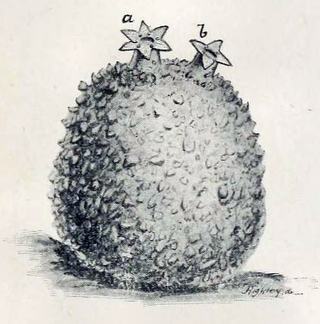
Molgula, or sea grapes, are very common, globular, individual marine tunicates roughly the size of grapes.
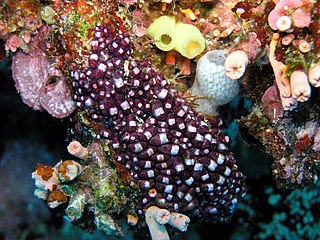
Eusynstyela is a genus of ascidian tunicates in the family Styelidae.

Phlebobranchia is an order of sea squirts in the class Ascidiacea, first described by Fernando Lahille in 1886.

Halocynthia is a genus of ascidian tunicates in the family Pyuridae. Species such as H. roretzi are eaten in parts of Asia as a delicacy.

Stolidobranchia is an order of tunicates in the class Ascidiacea. The group includes both colonial and solitary animals. They are distinguished from other tunicates by the presence of folded pharyngeal baskets. This provides the etymology of their name: in ancient Greek, στολίς, ίδος means the "fold" of a cloth. Stolidobranchian sea squirts are also characterized by the complete absence of an abdomen. The abdominal organs of other tunicates are instead located to one side of the pharyngeal basket in this group.
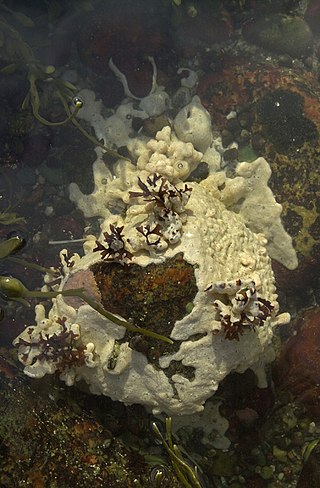
Aplousobranchia is an order of sea squirts in the class Ascidiacea, first described by Fernando Lahille in 1886. They are colonial animals, and are distinguished from other sea squirts by the presence of relatively simple pharyngeal baskets. This provides the etymology of their name: in ancient greek, ἁ.πλοος-ους (ha.ploos-ous) means "simple". The posterior part of the abdomen contains the heart and gonads, and is typically larger than in other sea squirts.
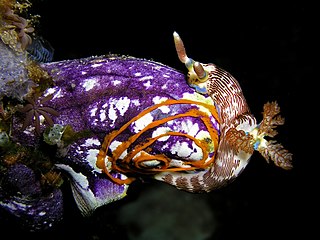
Styelidae is a family of ascidian tunicates.

Molgulidae is a family of tunicates in the class Ascidiacea. Following a revision in 2007, the family Hexacrobylidae was synonymized with Molgulidae.
Asajirus is a genus of marine tunicates. Asajirus indicus was found on the Antarctic Peninsula, west of Palmer Archipelago at a depth of 2763-2818m.
Molguloides is a genus of marine tunicates.
Pareugyrioides is a genus of marine tunicates.
Paramolgula is a genus of marine tunicates.
Alloeocarpa is a genus of ascidian tunicates in the family Styelidae.
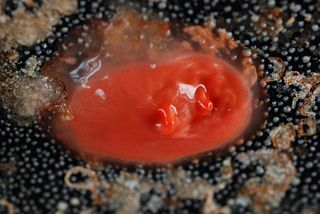
Cnemidocarpa is a genus of ascidian tunicates in the family Styelidae.

Distomus is a genus of ascidian tunicates in the family Styelidae.
Stolonica is a genus of ascidian tunicates in the family Styelidae.
Gamaster is a genus of ascidian tunicates in the family Molgulidae.
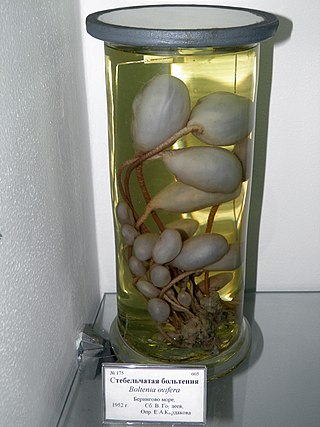
Boltenia is a genus of ascidian tunicates in the family Pyuridae.
Hartmeyeria is a genus of ascidian tunicates in the family Pyuridae.